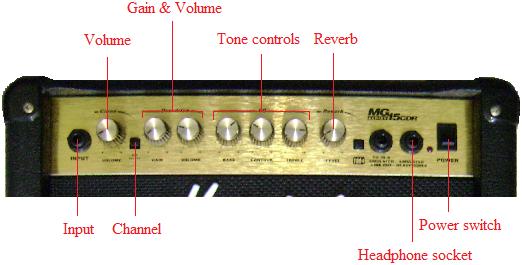Amplifiers
Amplifiers come in various sizes and can posses a variety of features. All amplifiers serve to provide volume and distortion and will usually come with some form of tone control. As a beginner to the guitar you will probably have a simple amplifier with controls such as the ones shown below:

Input
This is where you plug the lead that is coming from the guitar. Make sure that you connect the guitar to the amplifier with a lead before turning the power on.
Volume
Controls how loud the sound will be. Most amplifiers will have a volume control for a clean channel and one for a distorted channel. The volume on your guitar should always be on maximum, leaving you to adjust volume with the amplifiers volume control.
Channel
This button may also be labelled 'drive select' or something similar. If a clean channel is selected then there will be no distortion and only the volume control labelled 'clean' will control the level of sound. If the other channel is selected then you will be able to adjust the level of distortion with the gain control. Some amplifiers do not have a separate volume control for the distorted channel.
Gain
Controls the level of distortion. Gain also has an effect on the sustain, which is the amount of time a note sounds for. If you are finding it hard to get the sound you like using this control then try using the tone controls to adjust the quality of the sound.
Tone controls
The sound produced from a vibrating guitar string is actually a combination of various high and low pitches. Tone controls allow you to control the strength of the low, middle and high frequencies, enabling you to shape the quality of the sound. For a warmer and softer sound you may want to go easy on the treble and select a pickup that is near the neck of the guitar. For a distinct sound you may want to go easy on the bass and select the bridge pickup. To get a good sound when palm muting turn up the level of bass, especially if you are using distortion.
Reverb
Provides an echo-like effect that adds depth and warmth to the sound. Reverberations are formed when surfaces continually reflect sound and can be observed by listening to someone talk in a large room as opposed to a small enclosed space.
Headphone socket
Allows you to plug headphones in and spare your parent's sanity. Most headphones have a small jack and will need a 'small to big' jack adapter to fit in the socket of an amplifier.
Power switch
Switches the amp on and off.
Switching your amplifier on
- Make sure that the volume on your guitar and amplifier are fully down.
- Plug one end of the guitar lead into your guitar's jack socket and the other into the input of your amplifier.
- Press the power switch. A light should indicate that the power is on.
- Turn the volume on your guitar to maximum.
- Set the desired volume by using the amplifiers volume controls.
Switching your amplifier off
- Make sure that the volume on your guitar and amplifier are fully down.
- Press the power switch.
- Unplug the guitar lead.